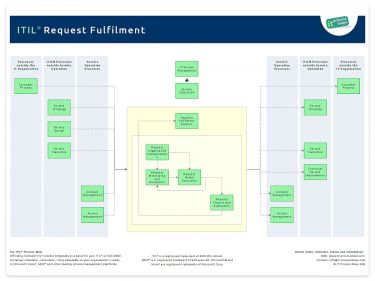Request Fulfilment
<seo metakeywords="request fulfilment, request fulfillment, itil request fulfilment, itil request fulfillment" metadescription="Request Fulfilment: ITIL process definition - Sub-processes - Terms - Additional information on Request Fulfilment." />

ITIL Request Fulfilment aims to fulfill Service Requests, which in most cases are minor (standard) Changes (e.g. requests to change a password) or requests for information.
Part of: Service Operation
Process Owner: Incident Manager
ITIL Request Fulfilment
Request Fulfilment Process
Request Fulfilment was added as a new process to ITIL V3 (ITIL 2007) with the aim to have a dedicated process dealing with Service Requests.

This was motivated by a clear distinction in ITIL V3 between Incidents (Service Interruptions) and Service Requests (standard requests from users, e.g. password resets).
In ITIL 2011, Request Fulfilment has been completely revised.
To reflect the latest guidance Request Fulfilment now consists of five sub-processes, to provide a detailed description of all activities and decision points.
Request Fulfilment now contains interfaces
- with Incident Management - if a Service Request turns out to be an Incident and
- with Service Transition - if fulfilling of a Service Request requires the involvement of Change Management.
A clearer explanation of the information that describes a Service Request and its life cycle has been added.
The concept of Service Request Models is explained in more detail.
These are the ITIL Request Fulfilment sub-processes:
- Request Fulfilment Support
- Process Objective: To provide and maintain the tools, processes, skills and rules for an effective and efficient handling of Service Requests.
- Request Logging and Categorization
- Process Objective: To record and categorize the Service Request with appropriate diligence and check the requester's authorization to submit the request, in order to facilitate a swift and effective processing.
- Request Model Execution
- Process Objective: To process a Service Request within the agreed time schedule.
- Request Monitoring and Escalation
- Process Objective: To continuously monitor the processing status of outstanding Service Requests, so that counter-measures may be introduced as soon as possible if service levels are likely to be breached.
- Request Closure and Evaluation
- Process Objective: To submit the Request Record to a final quality control before it is closed. The aim is to make sure that the Service Request is actually processed and that all information required to describe the request's life-cycle is supplied in sufficient detail. In addition to this, findings from the processing of the request are to be recorded for future use.
Downloads
Use the following links to open the process overview of Request Fulfilment showing the most important interfaces:
ITIL Terms
- Service Request
- Service Requests are formal requests from a user for something to be provided – for example, a request for information or advice; to reset a password; or to install a workstation for a new user.
- Service Request Model
- A (Service) Request Model defines specific agreed steps that will be followed for a Service Request of a particular type (or category).
- Service Request Record
- A record containing all details of a Service Request. Service Requests are formal requests from a user for something to be provided – for example, a request for information or advice; to reset a password; or to install a workstation for a new user.
- Service Request Status Information
- A message containing the present status of a Service Request, usually sent to a user who earlier requested a service.
ITIL Roles
- Incident Manager - Process Owner
- The Incident Manager is responsible for the effective implementation of the Incident Management process and carries out the respective reporting.
- He represents the first stage of escalation for Incidents, should these not be resolvable within the agreed Service Levels.
- 1st Level Support
- The responsibility of 1st Level Support is to register and classify received Incidents and to undertake an immediate effort in order to restore a failed IT service as quickly as possible.
- If no ad-hoc solution can be achieved, 1st Level Support will transfer the Incident to expert technical support groups (2nd Level Support).
- 1st Level Support also processes Service Requests and keeps users informed about their Incidents' status at agreed intervals.
- Service Request Fulfilment Group
- Service Request Fulfilment Groups specialize on the fulfillment of certain types of Service Requests.
- Typically, 1st Level Support will process simpler requests, while others are forwarded to the specialized Fulfilment Groups.
| Responsibility Matrix: ITIL Request Fulfilment | |||
| ITIL Role / Sub-Process | Incident Manager | 1st Level Support | Service Request Fulfilment Group |
|---|---|---|---|
| Request Fulfilment Support | A[1]R[2] | ||
| Request Logging and Categorization | A | R | |
| Request Model Execution | A | R | R |
| Request Monitoring and Escalation | AR | R | |
| Request Closure and Evaluation | A | R | |
Remarks
[1] A: Accountable according to the RACI Model: Those who are ultimately accountable for the correct and thorough completion of the Request Fulfilment process.
[2] R: Responsible according to the RACI Model: Those who do the work to achieve a task within Request Fulfilment.






